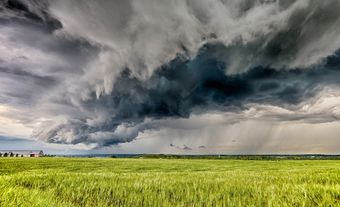A causeway is a raised path, railway or road across an expanse of low ground, wetlands or water. It is different from a bridge in that it has little or no opening underneath. Instead, it consists of a crest with embankments on either side. It is typically made of compacted earth, sand and rocks. In most cases, causeways are made by humans to connect different dry land areas to each other. Such connections can also be made up of a combination of causeway and bridge segments. Sometimes, a causeway can serve several purposes simultaneously. In addition to the passage it provides, the bulk of its structure may be intended to function as a dam or dike.

The Canso Causeway connects Cape Breton Island with mainland Nova Scotia.
("CapeBretonHighlands-CansoCauseway-0139" by Norman Maddeaux at Flickr is licensed under CC BY-NC-ND 2.0)
Causeways in Canada
One of the most famous Canadian causeways is Canso Causeway, which connects Cape Breton Island to mainland Nova Scotia. It was built between 1952 and 1955. As ferry traffic across the Strait of Canso increased, the causeway provided a permanent route for both vehicle and railway traffic. The causeway required over 10 million tons of rock to build. It is about 1,371 meters long and its foundation rests 66 meters below the surface.
Many smaller causeways can be found all over Canada. For example, Ontario’s LaSalle Causeway connects Kingston to Pittsburgh Township and was built in 1917. The connection consists of a combination of causeway segments and three bridges to allow navigability. Glenmore and McMeekan Causeways, in Calgary and Yellowknife respectively, are other examples of small, urban causeways.
Because causeways block most (if not all) water circulation, they sometimes have adverse effects on the environment and wildlife. This was the case for Petitcodiac Causeway in New Brunswick, which connects Moncton and Riverview by stretching across the Petitcodiac River. After the causeway’s construction was completed in 1968, fish migration was severely impeded. This was due to poor fishway design and sediment accumulation. Because of these and other environmental concerns, officials decided to replace the causeway with a bridge. Bridge construction began in 2017.

 Share on Facebook
Share on Facebook Share on X
Share on X Share by Email
Share by Email Share on Google Classroom
Share on Google Classroom



